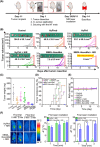Multifunctional Bioactive Dual-Layered Nanofibrous Matrix for Effective Breast Cancer Therapy and Enhanced Wound Healing
- PMID: 40296483
- PMCID: PMC12332832
- DOI: 10.1002/smll.202500717
Multifunctional Bioactive Dual-Layered Nanofibrous Matrix for Effective Breast Cancer Therapy and Enhanced Wound Healing
Abstract
Surgical resection is the primary treatment for triple-negative breast cancer (TNBC). Post-operative complications, including tumor recurrence and bacterial infections, hinder complete remission and long-term recovery. To address these challenges, a multifunctional bioactive dual-layered nanofibrous matrix (MBDL-NanoMat) featuring adaptive shape control, excellent wound adherence, tunable drug release profiles, and superior biocompatibility for post-surgical applications is developed. The MBDL-NanoMat comprises a hydrophilic (HyPhil) layer and a hydrophobic (HyPhob) layer, offering distinct functionalities. The HyPhil layer, electrospun with gelatin and copper peroxide nanoparticles (Cu NPs), rapidly releases Cu NPs to induce anticancer effects through chemodynamic therapy (CDT), ferroptosis, and cuproptosis along with antibacterial action. Near-infrared laser irradiation enhances therapeutic efficacy through photothermal therapy (PTT). The HyPhob layer ensures prolonged therapeutic effects by releasing therapeutic molecules, such as rapamycin, enabling sustained chemotherapy (CT) and antibacterial activity. This synergistic therapeutic system integrates multiple mechanisms-CT, CDT, PTT, ferroptosis, and cuproptosis-suppressing tumor recurrence and accelerating wound healing. Preclinical results demonstrated enhanced angiogenesis, collagen deposition, and dermal regeneration without systemic safety. In short, the MBDL-NanoMat platform offers a unique advantage in post-surgical TNBC care by simultaneously targeting tumor recurrence and facilitating wound healing. Further investigation of this platform can significantly improve oncological and regenerative medicine strategies.
Keywords: bacteria‐infected wound treatment; chemodynamic therapy (CDT); dual‐layered nanofibrous matrix; ferroptosis and cuproptosis; multifunctional biomaterials; photothermal therapy (PTT); triple‐negative breast cancer (TNBC).
© 2025 The Author(s). Small published by Wiley‐VCH GmbH.
Conflict of interest statement
The authors declare no conflict of interest.
Figures





References
-
- van der Eerden P. A., Lohuis P. J. F. M., Hart A. A. M., Mulder W. C., Vuyk H., Plast. Reconstr. Surg. 2008, 122, 1747. - PubMed
MeSH terms
Substances
Grants and funding
- RS-2024-00352515/National Research Foundation of Korea (NRF) grant funded by the Ministry of Science and ICT
- 2022R1A6C101A739/Korea Basic Science Institute (National Research Facilities and Equipment Center) grant funded by the Ministry of Education
- R21 NS132556/NS/NINDS NIH HHS/United States
- RM1 NS133003-01/NIH RM1
- OCRP/Congressionally Directed Medical Research Programs
- RM1 NS133003/NS/NINDS NIH HHS/United States
- AARG-NTF-21-847862/ALZ/Alzheimer's Association/United States
- RS-2018-NR031068/National Research Foundation of Korea (NRF) grant funded by the Ministry of Education
- OC220235P1/Congressionally Directed Medical Research Programs
- 2020R1C1C1003945/National Research Foundation of Korea (NRF) grant funded by the Ministry of Science and ICT
- R01 NS130836/NS/NINDS NIH HHS/United States
- COCR23PPR007/NJ Commission on Cancer Research
- R21 NS132556-01/NIH R21
- 1R01NS130836-01A1/NIH R01
LinkOut - more resources
Full Text Sources
Medical

